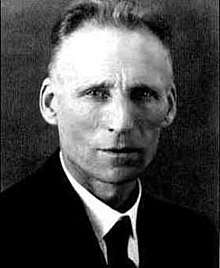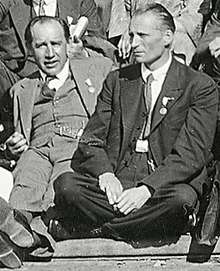L. E. J. Brouwer
Luitzen Egbertus Jan Brouwer (/ˈbraʊ.ər/; Dutch: [ˈlœy̯tsə(n) ɛɣˈbɛrtəs jɑn ˈbrʌu̯ər]; 27 February 1881 – 2 December 1966), usually cited as L. E. J. Brouwer but known to his friends as Bertus, was a Dutch mathematician and philosopher, who worked in topology, set theory, measure theory and complex analysis.[2][4][5] He was the founder of the mathematical philosophy of intuitionism.
L. E. J. Brouwer | |
|---|---|
 | |
| Born | Luitzen Egbertus Jan Brouwer 27 February 1881 |
| Died | 2 December 1966 (aged 85) |
| Nationality | Dutch |
| Alma mater | University of Amsterdam |
| Known for | Brouwer–Hilbert controversy Brouwer–Haemers graph Andries Brouwer 1951- Brouwer fixed-point theorem Brouwer–Heyting–Kolmogorov interpretation Jordan-Brouwer separation theorem Kleene–Brouwer order Phragmen–Brouwer theorem Tietze-Urysohn-Brouwer extension theorem Simplicial approximation theorem Bar induction Degree of a continuous mapping Indecomposability Invariance of domain Spread Proving hairy ball theorem |
| Awards | Foreign Member of the Royal Society[1] |
| Scientific career | |
| Fields | Mathematics |
| Institutions | University of Amsterdam |
| Doctoral advisor | Diederik Korteweg[2] |
| Doctoral students | Arend Heyting[2] |
| Influences | Immanuel Kant[3] Arthur Schopenhauer |
| Influenced | Hermann Weyl Michael Dummett Ludwig Wittgenstein |

Biography
Early in his career, Brouwer proved a number of theorems in the emerging field of topology. The most important were his fixed point theorem, the topological invariance of degree, and the topological invariance of dimension. Among mathematicians generally, the best known is the first one, usually referred to now as the Brouwer Fixed Point Theorem. It is a simple corollary to the second, concerning the topological invariance of degree, which is the best known among algebraic topologists. The third theorem is perhaps the hardest.
Brouwer also proved the simplicial approximation theorem in the foundations of algebraic topology, which justifies the reduction to combinatorial terms, after sufficient subdivision of simplicial complexes, of the treatment of general continuous mappings. In 1912, at age 31, he was elected a member of the Royal Netherlands Academy of Arts and Sciences.[6] He was an Invited Speaker of the ICM in 1908 at Rome[7] and in 1912 at Cambridge, UK.[8]
Brouwer founded intuitionism, a philosophy of mathematics that challenged the then-prevailing formalism of David Hilbert and his collaborators, who included Paul Bernays, Wilhelm Ackermann, and John von Neumann (cf. Kleene (1952), p. 46–59). A variety of constructive mathematics, intuitionism is a philosophy of the foundations of mathematics.[9] It is sometimes and rather simplistically characterized by saying that its adherents refuse to use the law of excluded middle in mathematical reasoning.
Brouwer was a member of the Significs Group. It formed part of the early history of semiotics—the study of symbols—around Victoria, Lady Welby in particular. The original meaning of his intuitionism probably can not be completely disentangled from the intellectual milieu of that group.
In 1905, at the age of 24, Brouwer expressed his philosophy of life in a short tract Life, Art and Mysticism, which has been described by the mathematician Martin Davis as "drenched in romantic pessimism" (Davis (2002), p. 94). Arthur Schopenhauer had a formative influence on Brouwer, not least because he insisted that all concepts be fundamentally based on sense intuitions.[10][11][12] Brouwer then "embarked on a self-righteous campaign to reconstruct mathematical practice from the ground up so as to satisfy his philosophical convictions"; indeed his thesis advisor refused to accept his Chapter II "as it stands, ... all interwoven with some kind of pessimism and mystical attitude to life which is not mathematics, nor has anything to do with the foundations of mathematics" (Davis, p. 94 quoting van Stigt, p. 41). Nevertheless, in 1908:
- "... Brouwer, in a paper entitled 'The untrustworthiness of the principles of logic', challenged the belief that the rules of the classical logic, which have come down to us essentially from Aristotle (384--322 B.C.) have an absolute validity, independent of the subject matter to which they are applied" (Kleene (1952), p. 46).
"After completing his dissertation, Brouwer made a conscious decision to temporarily keep his contentious ideas under wraps and to concentrate on demonstrating his mathematical prowess" (Davis (2000), p. 95); by 1910 he had published a number of important papers, in particular the Fixed Point Theorem. Hilbert—the formalist with whom the intuitionist Brouwer would ultimately spend years in conflict—admired the young man and helped him receive a regular academic appointment (1912) at the University of Amsterdam (Davis, p. 96). It was then that "Brouwer felt free to return to his revolutionary project which he was now calling intuitionism " (ibid).
He was combative as a young man. He was involved in a very public and eventually demeaning controversy in the later 1920s with Hilbert over editorial policy at Mathematische Annalen, at that time a leading learned journal. He became relatively isolated; the development of intuitionism at its source was taken up by his student Arend Heyting.
Dutch mathematician and historian of mathematics, Bartel Leendert van der Waerden attended lectures given by Brouwer in later years, and commented: "Even though his most important research contributions were in topology, Brouwer never gave courses in topology, but always on—and only on—the foundations of his intuitionism. It seemed that he was no longer convinced of his results in topology because they were not correct from the point of view of intuitionism, and he judged everything he had done before, his greatest output, false according to his philosophy."[13]
About his last years, Davis (2002) remarks:
- "...he felt more and more isolated, and spent his last years under the spell of 'totally unfounded financial worries and a paranoid fear of bankruptcy, persecution and illness.' He was killed in 1966 at the age of 85, struck by a vehicle while crossing the street in front of his house." (Davis, p. 100 quoting van Stigt. p. 110.)
Bibliography
In English translation
- Jean van Heijenoort, 1967 3rd printing 1976 with corrections, A Source Book in Mathematical Logic, 1879-1931. Harvard University Press, Cambridge MA, ISBN 0-674-32449-8 pbk. The original papers are prefaced with valuable commentary.
- 1923. L. E. J. Brouwer: "On the significance of the principle of excluded middle in mathematics, especially in function theory." With two Addenda and corrigenda, 334-45. Brouwer gives brief synopsis of his belief that the law of excluded middle cannot be "applied without reservation even in the mathematics of infinite systems" and gives two examples of failures to illustrate his assertion.
- 1925. A. N. Kolmogorov: "On the principle of excluded middle", pp. 414–437. Kolmogorov supports most of Brouwer's results but disputes a few; he discusses the ramifications of intuitionism with respect to "transfinite judgements", e.g. transfinite induction.
- 1927. L. E. J. Brouwer: "On the domains of definition of functions". Brouwer's intuitionistic treatment of the continuum, with an extended commentary.
- 1927. David Hilbert: "The foundations of mathematics," 464-80
- 1927. L. E. J. Brouwer: "Intuitionistic reflections on formalism," 490-92. Brouwer lists four topics on which intuitionism and formalism might "enter into a dialogue." Three of the topics involve the law of excluded middle.
- 1927. Hermann Weyl: "Comments on Hilbert's second lecture on the foundations of mathematics," 480-484. In 1920 Weyl, Hilbert's prize pupil, sided with Brouwer against Hilbert. But in this address Weyl "while defending Brouwer against some of Hilbert's criticisms...attempts to bring out the significance of Hilbert's approach to the problems of the foundations of mathematics."
- Ewald, William B., ed., 1996. From Kant to Hilbert: A Source Book in the Foundations of Mathematics, 2 vols. Oxford Univ. Press.
- 1928. "Mathematics, science, and language," 1170-85.
- 1928. "The structure of the continuum," 1186-96.
- 1952. "Historical background, principles, and methods of intuitionism," 1197-1207.
- Brouwer, L. E. J., Collected Works, Vol. I, Amsterdam: North-Holland, 1975.[14]
- Brouwer, L. E. J., Collected Works, Vol. II, Amsterdam: North-Holland, 1976.
- Brouwer, L. E. J., "Life, Art, and Mysticism," Notre Dame Journal of Formal Logic, vol. 37 (1996), pp. 389–429. Translated by W. P. van Stigt with an introduction by the translator, pp. 381–87. Davis quotes from this work, "a short book... drenched in romantic pessimism" (p. 94).
- W. P. van Stigt, 1990, Brouwer's Intuitionism, Amsterdam: North-Holland, 1990
See also
- Gerrit Mannoury
- George F. C. Griss
- Bar induction
- Constructivist epistemology
References
- Kreisel, G.; Newman, M. H. A. (1969). "Luitzen Egbertus Jan Brouwer 1881–1966". Biographical Memoirs of Fellows of the Royal Society. 15: 39–68. doi:10.1098/rsbm.1969.0002.
- L. E. J. Brouwer at the Mathematics Genealogy Project
- van Atten, Mark, "Luitzen Egbertus Jan Brouwer", The Stanford Encyclopedia of Philosophy (Spring 2012 Edition).
- O'Connor, John J.; Robertson, Edmund F., "L. E. J. Brouwer", MacTutor History of Mathematics archive, University of St Andrews.
- Atten, Mark van. "Luitzen Egbertus Jan Brouwer". In Zalta, Edward N. (ed.). Stanford Encyclopedia of Philosophy.
- "Luitzen E.J. Brouwer (1881 - 1966)". Royal Netherlands Academy of Arts and Sciences. Retrieved 21 July 2015.
- Brouwer, L. E. J. "Die mögliche Mächtigkeiten." Atti IV Congr. Intern. Mat. Roma 3 (1908): 569–571.
- Brouwer, L. E. J. (1912). Sur la notion de «Classe» de transformations d'une multiplicité. Proc. 5th Intern. Math. Congr. Cambridge, 2, 9–10.
- L. E. J. Brouwer (trans. by Arnold Dresden) (1913). "Intuitionism and Formalism". Bull. Amer. Math. Soc. 20 (2): 81–96. doi:10.1090/s0002-9904-1913-02440-6. MR 1559427.
- "...Brouwer and Schopenhauer are in many respects two of a kind." Teun Koetsier, Mathematics and the Divine, Chapter 30, "Arthur Schopenhauer and L.E.J. Brouwer: A Comparison," p. 584.
- Brouwer wrote that "the original interpretation of the continuum of Kant and Schopenhauer as pure a priori intuition can in essence be upheld." (Quoted in Vladimir Tasić's Mathematics and the roots of postmodernist thought, § 4.1, p. 36)
- “Brouwer’s debt to Schopenhauer is fully manifest. For both, Will is prior to Intellect." [see T. Koetsier. “Arthur Schopenhauer and L.E.J. Brouwer, a comparison,” Combined Proceedings for the Sixth and Seventh Midwest History of Mathematics Conferences, pages 272–290. Department of Mathematics, University of Wisconsin-La Crosse, La Crosse, 1998.]. (Mark van Atten and Robert Tragesser, “Mysticism and mathematics: Brouwer, Gödel, and the common core thesis,” Published in W. Deppert and M. Rahnfeld (eds.), Klarheit in Religionsdingen, Leipzig: Leipziger Universitätsverlag 2003, pp.145–160)
- "Interview with B L van der Waerden, reprinted in AMS March 1997" (PDF). American Mathematical Society. Retrieved 13 November 2015.
- Kreisel, G. (1977). "Review: L. E. J. Brouwer collected works, Volume I, Philosophy and foundations of mathematics ed. by A. Heyting" (PDF). Bull. Amer. Math. Soc. 83: 86–93. doi:10.1090/S0002-9904-1977-14185-2.
Further reading
- Dirk van Dalen, Mystic, Geometer, and Intuitionist: The Life of L. E. J. Brouwer. Oxford Univ. Press.
- 1999. Volume 1: The Dawning Revolution.
- 2005. Volume 2: Hope and Disillusion.
- 2013. L. E. J. Brouwer: Topologist, Intuitionist, Philosopher. How Mathematics is Rooted in Life. London: Springer (based on previous work).
- Martin Davis, 2000. The Engines of Logic, W. W. Norton, London, ISBN 0-393-32229-7 pbk. Cf. Chapter Five: "Hilbert to the Rescue" wherein Davis discusses Brouwer and his relationship with Hilbert and Weyl with brief biographical information of Brouwer. Davis's references include:
- Stephen Kleene, 1952 with corrections 1971, 10th reprint 1991, Introduction to Metamathematics, North-Holland Publishing Company, Amsterdam Netherlands, ISBN 0-7204-2103-9. Cf. in particular Chapter III: A Critique of Mathematical Reasoning, §13 "Intuitionism" and §14 "Formalism".
- Koetsier, Teun, Editor, Mathematics and the Divine: A Historical Study, Amsterdam: Elsevier Science and Technology, 2004, ISBN 0-444-50328-5.
External links
| Wikiquote has quotations related to: L. E. J. Brouwer |